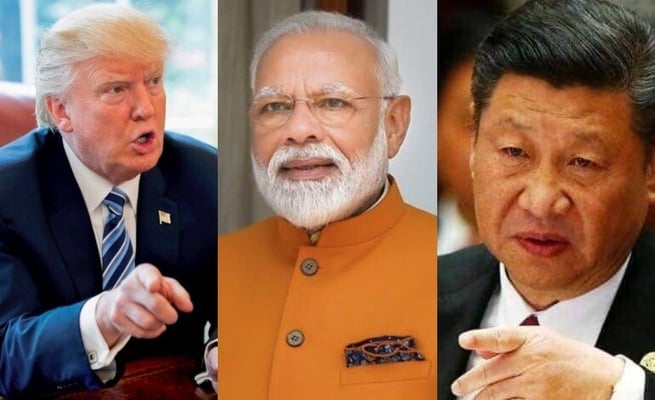Global Trade War and its impact on the Indian Economy

The current global trade war, as we know it, involves an escalation of import taxes or tariffs by US and China against each other as well as a number of other tariff escalations involving the US and its other trading partners, including India.
As of June 1 2019, the US has raised tariffs on $200bn of Chinese imports to 25 per cent from 10 per cent, threatening to impose tariffs of up to 25 per cent on all of US $600 billion-plus worth of imports coming from China. Likewise, China has already retaliated by increasing tariffs on mechanical parts, natural gas and skincare products exported by the US, from 10 per cent to 25 per cent previously, and by increasing the same on machinery, wood and optical instruments from 10 per cent to 20 percent, so far covering US $60 billion worth of its imports from the US.
As of 2018, the United States has been India’s largest export destinations, accounting for US$51.6 billion (16 per cent of total Indian exports). China accounting for $16.4 billion (5.1 per cent of India’s exports) is its 3rd largest export destination. So India is naturally “caught in the middle” of two of its biggest trading partners. Besides, based on a May 2018 notification to the WTO, India and the US have also experienced tariff escalations among themselves recently. Indian exporters face increased import tariffs in the US since 2018, for metals and metal products including aluminium, iron and steel, motor vehicles and parts, machinery electronic equipment and chemical rubber plastics (CRP). Likewise, US exporters to India face the same in exports of vegetables, fruits and nuts, animal products, as well as also on the manufacturing sector including iron and steel and CRP sectors. More recently, as of last week, the US has also decided to terminate India’s status as a beneficiary of the Generalized System of Preferences (GSP). This means that about US $260 million (equivalent to about 0.5 per cent) of India’s exports to the US (including leather articles, imitation jewellery as well as pharmaceuticals and surgical equipment) that hitherto enjoyed preferential tariff-free access, will no longer be tariff-free.
In the above backdrop, how is the global trade war likely to impact upon the Indian economy, in terms of growth, trade and employment? A team of trade economists from the US, New Zealand and India have been working on this using a global trade model. Their research findings so far, suggest that even if “threatened” tariffs up to May 2019 are considered, India does not lose from the ongoing trade war. Their estimates suggest that there could be 0.06 per cent gain in real GDP for the Indian economy, with unskilled labour employment and investment growth likely to increase. However, a trade war would almost certainly adversely affect India’s export growth by about 1.03 per cent, thereby increasing the trade deficit.
Why would India gain in spite of an ongoing tariff escalation that involves itself and the US? A key to understanding this is the dynamics of changes in India’s export prices and import prices, that ultimately also impact upon its Terms of Trade, a key indicator of welfare competitiveness. First, as producers in the United States and China experience oversupply (due to blocked markets because of the trade war), this leads their export prices to third markets (India in this case) to decline. This leads to fall in import prices for India, benefitting both consumers and intermediate producers there. Second, since exporters in India are not blocked by increasing tariffs in China, they experience increases in their export prices, as they fill in the gaps opened by the exclusion of United States in that market (e.g. this could happen with US GSP excluded exports from India now exported to China). The combination of these two dynamics leads to improved terms of trade for India (rising export prices compared to falling import prices), that contributes to the overall positive outcome so far. This is also the likely outcome for New Zealand (a third-country partner in this trade war) so far.
An important caveat is in order here. The situation is constantly evolving, and there is a real danger that the trade war will spin off next into the digital economy, as technology products are next in the firing line of 25 per cent tariffs from the US if the situation does not get resolved by end June 2019. This is likely to include products such as computers, TVs, game consoles, smartphones and their parts and components). This, along with any move to restrict technology transfers, will potentially disrupt global value chains and could have far-reaching adverse consequences for India, New Zealand and the global economy at large, depending on the extent to which the trade war escalates, and businesses are able to respond to. In that sense, the long-term effects of a prolonged global trade on the Indian economy, as well as New Zealand remains clearly uncertain.

Note: The author is Senior Lecturer, School of Economics, Faculty of Business Economics and Law, at AUT, Auckland, besides being a Fellow, New Zealand-India Research Institute (NZIRI). The views expressed here are personal.
The current global trade war, as we know it, involves an escalation of import taxes or tariffs by US and China against each other as well as a number of other tariff escalations involving the US and its other trading partners, including India.
As of June 1 2019, the US has raised tariffs on $200bn...
The current global trade war, as we know it, involves an escalation of import taxes or tariffs by US and China against each other as well as a number of other tariff escalations involving the US and its other trading partners, including India.
As of June 1 2019, the US has raised tariffs on $200bn of Chinese imports to 25 per cent from 10 per cent, threatening to impose tariffs of up to 25 per cent on all of US $600 billion-plus worth of imports coming from China. Likewise, China has already retaliated by increasing tariffs on mechanical parts, natural gas and skincare products exported by the US, from 10 per cent to 25 per cent previously, and by increasing the same on machinery, wood and optical instruments from 10 per cent to 20 percent, so far covering US $60 billion worth of its imports from the US.
As of 2018, the United States has been India’s largest export destinations, accounting for US$51.6 billion (16 per cent of total Indian exports). China accounting for $16.4 billion (5.1 per cent of India’s exports) is its 3rd largest export destination. So India is naturally “caught in the middle” of two of its biggest trading partners. Besides, based on a May 2018 notification to the WTO, India and the US have also experienced tariff escalations among themselves recently. Indian exporters face increased import tariffs in the US since 2018, for metals and metal products including aluminium, iron and steel, motor vehicles and parts, machinery electronic equipment and chemical rubber plastics (CRP). Likewise, US exporters to India face the same in exports of vegetables, fruits and nuts, animal products, as well as also on the manufacturing sector including iron and steel and CRP sectors. More recently, as of last week, the US has also decided to terminate India’s status as a beneficiary of the Generalized System of Preferences (GSP). This means that about US $260 million (equivalent to about 0.5 per cent) of India’s exports to the US (including leather articles, imitation jewellery as well as pharmaceuticals and surgical equipment) that hitherto enjoyed preferential tariff-free access, will no longer be tariff-free.
In the above backdrop, how is the global trade war likely to impact upon the Indian economy, in terms of growth, trade and employment? A team of trade economists from the US, New Zealand and India have been working on this using a global trade model. Their research findings so far, suggest that even if “threatened” tariffs up to May 2019 are considered, India does not lose from the ongoing trade war. Their estimates suggest that there could be 0.06 per cent gain in real GDP for the Indian economy, with unskilled labour employment and investment growth likely to increase. However, a trade war would almost certainly adversely affect India’s export growth by about 1.03 per cent, thereby increasing the trade deficit.
Why would India gain in spite of an ongoing tariff escalation that involves itself and the US? A key to understanding this is the dynamics of changes in India’s export prices and import prices, that ultimately also impact upon its Terms of Trade, a key indicator of welfare competitiveness. First, as producers in the United States and China experience oversupply (due to blocked markets because of the trade war), this leads their export prices to third markets (India in this case) to decline. This leads to fall in import prices for India, benefitting both consumers and intermediate producers there. Second, since exporters in India are not blocked by increasing tariffs in China, they experience increases in their export prices, as they fill in the gaps opened by the exclusion of United States in that market (e.g. this could happen with US GSP excluded exports from India now exported to China). The combination of these two dynamics leads to improved terms of trade for India (rising export prices compared to falling import prices), that contributes to the overall positive outcome so far. This is also the likely outcome for New Zealand (a third-country partner in this trade war) so far.
An important caveat is in order here. The situation is constantly evolving, and there is a real danger that the trade war will spin off next into the digital economy, as technology products are next in the firing line of 25 per cent tariffs from the US if the situation does not get resolved by end June 2019. This is likely to include products such as computers, TVs, game consoles, smartphones and their parts and components). This, along with any move to restrict technology transfers, will potentially disrupt global value chains and could have far-reaching adverse consequences for India, New Zealand and the global economy at large, depending on the extent to which the trade war escalates, and businesses are able to respond to. In that sense, the long-term effects of a prolonged global trade on the Indian economy, as well as New Zealand remains clearly uncertain.

Note: The author is Senior Lecturer, School of Economics, Faculty of Business Economics and Law, at AUT, Auckland, besides being a Fellow, New Zealand-India Research Institute (NZIRI). The views expressed here are personal.









Leave a Comment